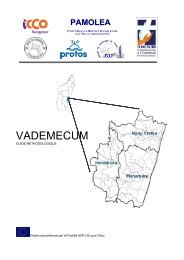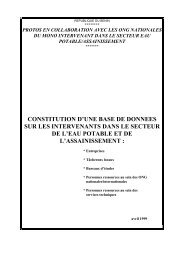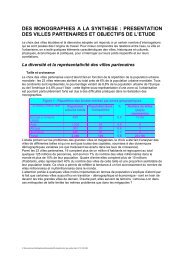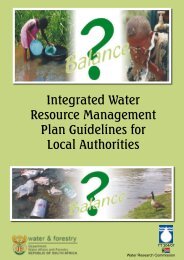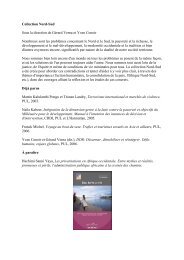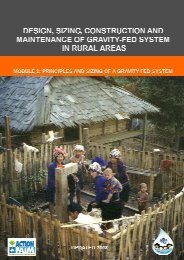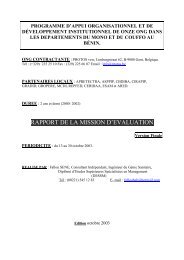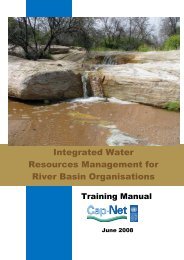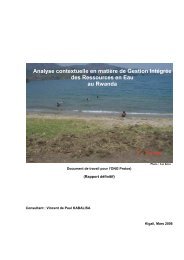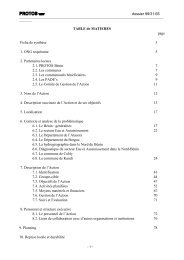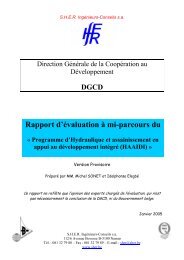table of contents preamble 1. summary - ACT - Advanced ...
table of contents preamble 1. summary - ACT - Advanced ...
table of contents preamble 1. summary - ACT - Advanced ...
Create successful ePaper yourself
Turn your PDF publications into a flip-book with our unique Google optimized e-Paper software.
8. CONCLUSIONS AND RECOMMANDATIONS<br />
8.<strong>1.</strong> CONCLUSIONS<br />
Identification and preparation <strong>of</strong> the project<br />
- The project is a continuation <strong>of</strong> a limited action set up by SOCADIDO in the period<br />
between ’92 and ’95 financed by Cebemo/Bilance. The mistakes <strong>of</strong> this first experimental<br />
phase were simply passed on at the start <strong>of</strong> the CMWS project : inadequate technicality at<br />
the spring protections, no approach concerning the community mobilisation and no clear<br />
strategy yet concerning the linkage between water, sanitation, hygiene and health.<br />
- About three years passed between the first formulation <strong>of</strong> the project and the actual start.<br />
This was due on the one hand to the limited capacities within SOCADIDO and on the<br />
other hand to the defective communication between SOCADIDO and its financing partner<br />
Cebemo/Bilance.<br />
- At the formulation <strong>of</strong> the project proposal there was little participation from SOCADIDO<br />
where at that time no one was enough specialised in the sector to contribute to the<br />
conception <strong>of</strong> the project, which had thus been confided to externals.<br />
Relevance<br />
- The project is indeed relevant and responds to primary needs <strong>of</strong> the target group. The<br />
faulty drinking water supply in the area was also aggravated during the uns<strong>table</strong> period till<br />
‘92-’93. Better hygiene and sanitation is at first not perceived by the target group as a<br />
priority, but once the link between water, sanitation, hygiene and health has been better<br />
understood the beneficiaries are strongly interested.<br />
- The coverage in the target area related to drinking water is about 40% and about 20% for<br />
the latrines. With a limited number <strong>of</strong> other actors investing in the sector there is certainly<br />
room for the CMWS programme <strong>of</strong> SOCADIDO. Besides the project applies itself to<br />
techniques that are less promoted by the other actors (spring protections and hand-augured<br />
wells), thus resulting in a good complementarity.<br />
- The project subscribes to the national and regional strategy in relation to drinking water<br />
and sanitation. In the starting phase though a number <strong>of</strong> hand pumps were used which did<br />
not comply with the strategy <strong>of</strong> regional uniformisation. It is also possible to strive for a<br />
better collaboration with the government services and with the WATSAN committees at<br />
the level <strong>of</strong> the subcounties and the counties.<br />
Effectiveness<br />
- On the quantitative level the project has not realised its proposed objectives. At the most<br />
half <strong>of</strong> the number <strong>of</strong> proposed water points will be finished by the end <strong>of</strong> the project. This<br />
is partly due to the inexperience <strong>of</strong> the team (which was completely new and engaged<br />
beginning <strong>of</strong> ’97), partly to a wrong estimate <strong>of</strong> cost prices and execution delays during<br />
the formulation, and partly to the – certainly justified – priority the team wishes to give to<br />
quality, to building their own capacities and to the development <strong>of</strong> an adapted approach.<br />
- The quality <strong>of</strong> the installed water points has greatly improved since the backstopping<br />
mission <strong>of</strong> May ’98. Before the spring protections were <strong>of</strong> a bad quality giving unclear<br />
water, which also had a negative influence on the sustainability <strong>of</strong> the construction. The<br />
boreholes were <strong>of</strong>ten situated too close to the swamps so there was an infiltration <strong>of</strong><br />
38




